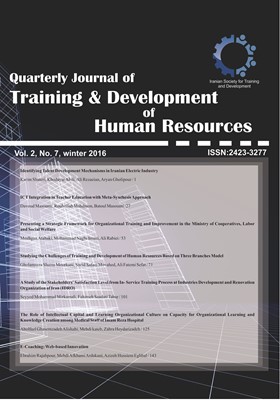Identifying Talent Development Mechanisms in Iranian Electric Industry
Subject Areas :
1
,
Khodayar Abili
2
,
3
,
Aryan gholipour
4
![]()
1 - University of Tehran
2 - University of Tehran
3 -
4 - مدیریت
Keywords: Talent Management Talent Development Mechanisms Iranian Electric Industry,
Abstract :
The current study aimed to identify talent development mechanisms in Iranian electric industry applying a mixed method approach. In qualitative phase, statistical population included academic informants and electric industry’s human resource managers and talents from whom 19 people were purposefully selected and profoundly interviewed. The collected qualitative data were analyzed using thematic analysis technique and its validity was confirmed applying member checking, data source triangulation and peer debriefing techniques. In quantitative phase, statistical population consisted of 279 talents from which 134 people were selected randomly as a sample using levy and lemeshaw (1981) formula. Data was collected applying researched- administered questionnaire which contain 56 questions. Structural equation modeling with partial least squares (PLS) approach was used to analyses the collected data. So, in order to do second order confirmatory factor analysis, Smart-PLS3 was utilized. Finally, findings obtained from thematic analysis showed that the main talent development mechanisms in Iranian electric industry were categorized into Internal/external organizational sessions, vertical career path, horizontal career path, self- development, coaching, succession planning, training, performance management, job design techniques, team working, learning by doing, knowledge sharing, and networking. Results of one sample t- test indicated that all identified mechanisms were evaluated adequately by electric industry’s talents. Furthermore, confirmatory factor analysis’ results showed that all observable and latent variables’ factor loading were above 0.70 and were confirmed at 0.01 levels. In other words, the 13 mechanisms identified in qualitative phase can be considered as the fundamental factors of talent development and it can be predicted applying them
ابیلی، خدایار. (1389). مدیریت منابع انسانی (با تأکید بر رویکردهای نوین). تهران: سازمان مدیریت صنعتی.
قلیپور، آرین. (1390). مدیریت منابع انسانی( مفاهیم، تئوریها و کاربردها). تهران: سمت.
Agarwal, R & Corey, M. (2009). The Performance Effects of Coaching: A Multilevel Analysis Using Hierarchical Linear Modeling. International journal of human resource management, 20(10), 2110-2134.
Armstrong, M. (2006). Human resource management practice. 10th edition. Printed and bound in Great Britain by Cambridge University Press.
Axelrod, E., Handfield-Jones, H., & Timothy Welsh. (2001). The war on talent, part two. McKinsey Quarterly, No. 2.
Beardwell, J. & Claydon, T. (2007). Human Resource Management: A Contemporary Approach. 5th edition, Prentice hall.
Cai, W., & Klyushina, U. (2009). Talent retention and development within multinational company in China, Retrieved from: http://lnu.diva-portal.org/smash/record.jsf?pid=diva2%3A220648&dswid=30.
charity, N. L. C. (2011). An investigation of talent management and staff retention at the bank of Zambia. Business Administration, Master of Business Administration, the Nelson Mandela Metropolitan University Business School.
Collings, D. G., Scullion, H., & Vaiman, V. (2015). Talent management: Progress and prospects. Human Resource Management Review, 25(3), 233–235.
Davies, B., & Davies, B. J. (2010). Talent Management in Academies. International Journal of Educational Management, 24(5), 418–426.
DeCenzo, David A. & Robbins, Stephen P. (2010). Fundamentals of Human Resource Management. Tenth Edition, John Wiley & Sons, Inc.
Festing, M., & Schäfer, L. (2014). Generational challenges to talent management: A framework for talent retention based on the psychological-contract perspective. Journal of World Business, 49(2), 262–271.
Frank, F. D., Finnegan, R. P., & Taylor, C. R. (2004.). The race for talent: retaining and engaging workers in the 21st Century. Human Resource Planning, 27 (3), 12-25.
Gallardo-Gallardo, E., Dries, N., & González-Cruz, T. F. (2013). What is the meaning of “talent” in the world of work?. Human Resource Management Review, 23(4), 290–300.
Garavan, T. N., Carbery, R., & Rock, A. (2012). Mapping talent development: definition, scope and architecture. European Journal of Training and Development, 36(1), 5–24.
Greer, Charles R. (2001). Strategic Human Resource Management. Second Edition, Prentice-Hall, Inc, A Pearson Education Company, New Jersey.
Haskins, M. E., & Shaffer, G. R. (2010). A talent development framework: tackling the puzzle. Development and Learning in Organizations: An International Journal, 24(1), 13-16.
Kalamas, D. & Kalamas J. B. (2004). Developing Employee Capital: Setting the Stage for Lifelong Learning. HRD Press, Inc, Massachusetts.
Kermally, S. (2004). Developing and Managing Talent. London: Thorogood.
Kvale, Steinar. (1996). Interviews: An Introduction to qualitative research interviewing. Thousand Oaks, CA: Sage.
Levy, P.S. & Lemeshow, S. (1999). Sampling of population. John Wiley, Newyork.
Lewis, R. E., & Heckman, R. J. (2006). Talent management: A critical review. Human Resource Management Review, 16(2), 139–154.
Mahapatro, b. b. (2010). Human resource management. Published by New Age International Publishers.
Mathis, R. L., & Jackson, J. (2011). Human resource management: Essential perspectives. Cengage Learning, USA.
Meyers, M. C., & van Woerkom, M. (2014). The influence of underlying philosophies on talent management: Theory, implications for practice, and research agenda. Journal of World Business, 49(2), 192–203.
Morton, L. (2004). Integrated and Integrative Talent Management: A Strategic HR Framework, Research Report R-1345-04-RR, New York: The Conference Board.
Phillips, D. R., & Roper, K. O. (2009). A framework for talent management in real estate. Journal of Corporate Real Estate, 11(1), 7–16.
Raida A. Al-Awamleh. (2009). Developing Future Leaders: The contribution of Talent Management. Phd thesis in Business Administration, Greenleaf University.
Sharrat, M. and Usoro, A. (2003). Understanding Knowledge-Sharing in Online Communities of Practice. Electronic Journal on Knowledge Management, 1(2), 187-196.
Stewart, Greg L. & Brown, Kenneth G. (2011). Human Resource Management: Linking Strategy to Practice. Second edition, John Wiley & Sons, Inc.
Tansly, C. (2011). What do we mean by the term “Talent” in talent management?. Industrial and commercial training, 43(5). pp: 266-274.
Wang-Cowham, C. (2011). Developing talent with an integrated knowledge-sharing mechanism: an exploratory investigation from the Chinese human resource managers’ perspective. Human Resource Development International, 14(4), 391–407.
Willem, A. (2003). The Role of Organization Specific Integration Mechanisms in Inter-Unit Knowledge Sharing. PhD Dissertation at Vlerick Leuven Gent Management School, Ghent University, Belgiu


